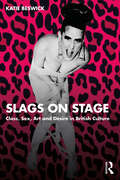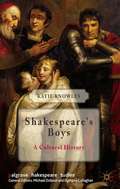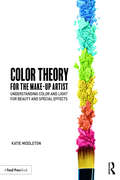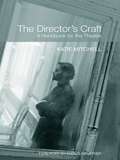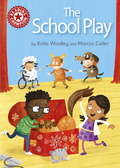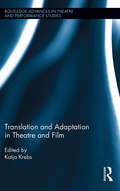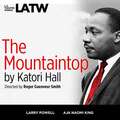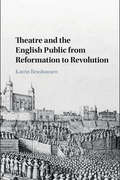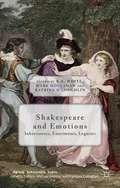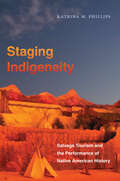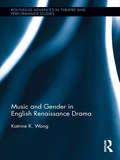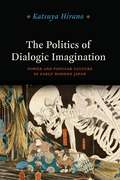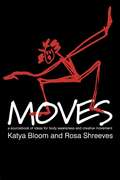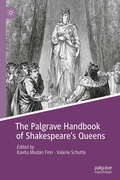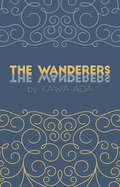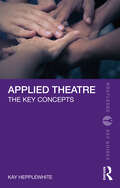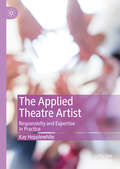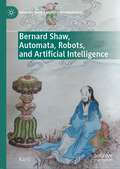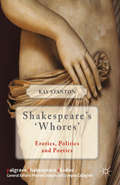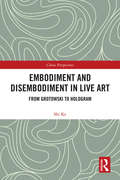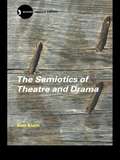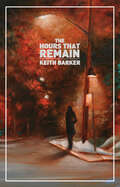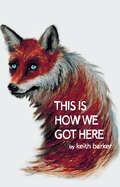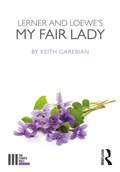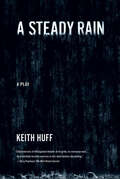- Table View
- List View
Slags on Stage: Class, Sex, Art and Desire in British Culture
by Katie BeswickSlags on Stage weaves cultural analysis with poetry and art criticism to explore the concept of the ‘slag’ and its place in contemporary British culture.The book traces the etymology of the word slag through the twentieth and into the twenty-first century, thinking through the ways ‘slag’ speaks to issues of class, sex and desire. Broadly, slag is an insult bound up with women’s sexual reputations – but beyond this it is a ‘key’ word that shapes the ways we debate and understand what it means to be a woman. For women who came of age in the United Kingdom in the late twentieth and early twenty-first centuries ‘slag’ produces complex feelings and has influenced how we have come to know ourselves and understand our sexual and quotidian desires. This book explores the terrain of slag and includes analyses of artworks by artists who have invoked the slag in their practice, including Tracey Emin, Cash Carraway and Michaela Coel. Covering the cultural politics of clothing, motherhood, television representations, sexual assault, sex work and desire, Slags on Stage asks: what role does the ‘slag’ play in British culture? Who is she for? And how have women used sex and sexuality to have their own say in cultures that want to control them?This is a fascinating exploration for students and scholars of British drama, theatre and performance, cultural studies and sociology.
Shakespeare’s Boys
by Katie KnowlesShakespeare's Boys: A Cultural Historyis the first extensive exploration of boyhood in Shakespeare's plays. It examines a range of characters from Shakespeare's comedies, histories and tragedies in their original early modern contexts and surveys their performance histories on stage and screen from the Restoration until the present day. Focusing on the status of aristocratic boys, the transition from boyhood to manhood and methods of education, it argues that the varied and complex portrayal of boys in Shakespeare reflects the ambiguous and transitional status of boyhood in early modern England, and that the portrayal of these on-stage boys has been a crucial, and sometimes defining, factor in the performance history of Shakespeare's plays. This study embraces this idea of characters in flux, reading Shakespearean boyhood as a continuum in which each historical reincarnation depends upon and reacts against what came before, while influencing what is to come.
Color Theory for the Makeup Artist: Understanding Color and Light for Beauty and Special Effects
by Katie MiddletonColor Theory for the Make-up Artist: Understanding Color and Light for Beauty and Special Effects analyzes and explains traditional color theory for fine artists and applies it to the make-up artist. This book is suitable for both professionals and beginners who wish to train their eye further to understand and recognize distinctions in color. It explains why we see color, how to categorize and identify color, relationships between colors, and it relates these concepts to beauty and special effects make-up. The book teaches the reader how to mix flesh tones by using only primary colors, and explains how these colors in paints and make-up are sourced and created. It also discusses the reason for variations in skin colors and undertones, and how to identify and match these using make-up, while choosing flattering colors for the eyes, lips, and cheeks. Colors found inside the body are explained for special effects make-up, like why we bruise, bleed, or appear sick. Ideas and techniques are also described for painting prosthetics, in addition to using color as inspiration in make-up designs. The book also discusses how lighting affects color on film, television, theater, and photography sets, and how to properly light a workspace for successful applications.
The Director's Craft: A Handbook for the Theatre
by Katie MitchellThe Director's Craft is a unique and completely indispensable step-by-step guide to directing for the stage. Written by one of the most adventurous and respected directors working today, this book will be an essential item in every student and practitioner's kitbag. It provides detailed assistance with each aspect of the varied challenges facing all theatre directors, and does so with startling clarity. It will inspire everyone, from the beginner just starting out to the experienced practitioner looking to reinvigorate their practice. Katie Mitchell shares and explains the key practical tools she uses to approach her work with both actors, production teams, and the text itself. She addresses topics such as: the ideas that underpin a play's text preparing improvizations Twelve Golden Rules for working with actors managing the transition from rehearsal room to theatre analyzing your work after a run has ended. Each chapter concludes with a summary of its critical points, making this an ideal reference work for both directors and actors at any stage of their development.
The School Play: Independent Reading Red 2 (Reading Champion #367)
by Katie WoolleyLil and Tim are having trouble choosing an outfit for the school play ... what will they be?Reading Champion offers independent reading books for children to practise and reinforce their developing reading skills.Fantastic, original stories are accompanied by engaging artwork and a reading activity. Each book has been carefully graded so that it can be matched to a child's reading ability, encouraging reading for pleasure. Perfect for the 4-5 year old beginner reader or those reading book band red.
Translation and Adaptation in Theatre and Film (Routledge Advances in Theatre & Performance Studies)
by Katja KrebsThis book provides a pioneering and provocative exploration of the rich synergies between adaptation studies and translation studies and is the first genuine attempt to discuss the rather loose usage of the concepts of translation and adaptation in terms of theatre and film. At the heart of this collection is the proposition that translation studies and adaptation studies have much to offer each other in practical and theoretical terms and can no longer exist independently from one another. As a result, it generates productive ideas within the contact zone between these two fields of study, both through new theoretical paradigms and detailed case studies. Such closely intertwined areas as translation and adaptation need to encounter each other’s methodologies and perspectives in order to develop ever more rigorous approaches to the study of adaptation and translation phenomena, challenging current assumptions and prejudices in terms of both. The book includes contributions as diverse yet interrelated as Bakhtin’s notion of translation and adaptation, Bollywood adaptations of Shakespeare’s Othello, and an analysis of performance practice, itself arguably an adaptive practice, which uses a variety of languages from English and Greek to British and International Sign-Language. As translation and adaptation practices are an integral part of global cultural and political activities and agendas, it is ever more important to study such occurrences of rewriting and reshaping. By exploring and investigating interdisciplinary and cross-cultural perspectives and approaches, this volume investigates the impact such occurrences of rewriting have on the constructions and experiences of cultures while at the same time developing a rigorous methodological framework which will form the basis of future scholarship on performance and film, translation and adaptation.
The Mountaintop
by Katori HallOn April 4, 1968, Martin Luther King Jr. was assassinated outside of his room at the Lorraine Motel in Memphis. What happened inside room 306 on the evening of April 3 is the subject of Katori Hall's The Mountaintop. Hours after King's final speech, punctuated by his immortal line "I've been to the mountaintop", the celebrated reverend forms an unlikely friendship with a motel maid as they talk into the early hours of what will be his final day.
Theatre and the English Public from Reformation to Revolution
by Katrin BeushausenThis book presents new and overarching perspectives on the relationship between theatre and public from the Henrician Reformation through the interregnum to the Restoration, combining vivid case studies with discussion of theatre's continued importance in shaping the early modern public. Considered from the vantage point of theatre, the early modern public becomes visible as an unruly agent of political change, a force that authorities both feared and appealed to, and one that proved ultimately beyond control. It was through theatrical strategies that rulers and their opposition addressed the early modern public, and in turn it was theatre's public potential that shaped the development of the stage during the revolutionary years of the seventeenth century.<P><P> In this volume, Katrin Beushausen examines sources including irreverent satirical pamphlets, regal spectacles, anti-theatrical polemic and visions of state theatres, casting new light on the development of the early modern public and theatre. <P> Sheds new light on the English Civil War and Commonwealth period, discussing theatre under prohibition and filling in important blanks in the history of the English stage.<P> Provides fresh insights into the literary and theatrical culture of the Interregnum, using theatre studies methodology to interpret numerous primary sources and case studies.<P> Charts the impact of theatre on the early modern public under different regimes from the early sixteenth century to the late seventeenth century.
Shakespeare and Emotions
by Katrina O’loughlin R. S. White Mark HoulahanThis collection of original essays by established and emerging scholars approaches the works of Shakespeare from the topical perspective of the History of Emotions. What emerges is not a single paradigm or 'grand narrative', but a variety of approaches, ranging from the historical to the interpretive, illuminating the primacy of emotions in Shakespearean scholarship and theatre. The section 'Emotional Inheritances' looks back to Shakespeare's sources and cultural backgrounds, showing that some aspects of his representations of emotions come from the classics and medieval world; 'Shakespearean Enactments' presents essays that analyse a range of emotional states and issues in the plays themselves; while 'Legacies and Re-Enactments' traces aspects of his influence through later times and down to the present day. Taken together these diverse but related essays present a kaleidoscope of suggestive approaches to the potentially endless subject of emotions in Shakespeare.
Staging Indigeneity: Salvage Tourism and the Performance of Native American History
by Katrina PhillipsAs tourists increasingly moved across the United States in the late nineteenth and early twentieth centuries, a surprising number of communities looked to capitalize on the histories of Native American people to create tourist attractions. From the Happy Canyon Indian Pageant and Wild West Show in Pendleton, Oregon, to outdoor dramas like Tecumseh! in Chillicothe, Ohio, and Unto These Hills in Cherokee, North Carolina, locals staged performances that claimed to honor an Indigenous past while depicting that past on white settlers' terms. Linking the origins of these performances to their present-day incarnations, this incisive book reveals how they constituted what Katrina Phillips calls "salvage tourism"—a set of practices paralleling so-called salvage ethnography, which documented the histories, languages, and cultures of Indigenous people while reinforcing a belief that Native American societies were inevitably disappearing. Across time, Phillips argues, tourism, nostalgia, and authenticity converge in the creation of salvage tourism, which blends tourism and history, contestations over citizenship, identity, belonging, and the continued use of Indians and Indianness as a means of escape, entertainment, and economic development.
Music and Gender in English Renaissance Drama (Routledge Advances in Theatre & Performance Studies)
by Katrine K. WongThis book offers a survey of how female and male characters in English Renaissance theatre participated and interacted in musical activities, both inside and outside the contemporary societal decorum. Wong’s analysis broadens our understanding of the general theatrical representation of music, or musical dramaturgy, and complicates the current discussion of musical portrayal and construction of gender during this period. Wong discusses dramaturgical meanings of music and its association with gender, love, and erotomania in Renaissance plays. The negotiation between the dichotomous qualities of the heavenly and the demonic finds extensive application in recent studies of music in early modern English plays. However, while ideological dualities identified in music in traditional Renaissance thinking may seem unequivocal, various musical representations of characters and situations in early modern drama would prove otherwise. Wong, building upon the conventional model of binarism, explores how playwrights created their musical characters and scenarios according to the received cultural use and perception of music, and, at the same time, experimented with the multivalent meanings and significance embodied in theatrical music.
The Politics of Dialogic Imagination: Power and Popular Culture in Early Modern Japan (Chicago Studies in Practices of Meaning)
by Katsuya HiranoIna"The Politics of Dialogic Imagination," Katsuya Hirano seeks to understand why, with its seemingly unrivaled power, the Tokugawa shogunate of early modern Japan tried so hard to regulate the ostensibly unimportant popular culture of Edo (present-day Tokyo)OCoincluding fashion, leisure activities, prints, and theater. He does so by examining the works of writers and artists who depicted and celebrated the culture of play and pleasure associated with EdoOCOs street entertainers, vagrants, actors, and prostitutes, whom Tokugawa authorities condemned to be detrimental to public mores, social order, and political economy. Hirano uncovers a logic of politics within EdoOCOs cultural works that was extremely potent in exposing contradictions between the formal structure of the Tokugawa world and its rapidly changing realities. He goes on to look at the effects of this logic, examining policies enacted during the next eraOCothe Meiji periodOCothat mark a drastic reconfiguration of power and a new politics toward ordinary people under modernizing Japan. Deftly navigating JapanOCOs history and culture, a"The Politics of Dialogic Imagination"provides a sophisticated account of a country in the process of radical transformationOCoand of the intensely creative culture that came out of it. "
Moves: A Sourcebook of Ideas for Body Awareness and Creative Movement
by Katya Bloom Rosa ShreevesFirst Published in 1998. The aim of this book is to reawaken awareness of the body feels; rekindle imagination; provide starting points for both developing greater self-awareness and creating expressive movement. 'Moves' suggests a wealth of exercises which stem from the natural movement of the body and are therefore accessible to anyone. As you respond to the material in this book you may notice changes in yourself, such as greater physical and emotional freedom, a lessening of anxiety and constriction, a new found sense of flow, flexibility and strength and a greater responsiveness to others and to the environment.
The Palgrave Handbook of Shakespeare's Queens (Queenship and Power)
by Valerie Schutte Kavita Mudan FinnOf Shakespeare’s thirty-seven plays, fifteen include queens. This collection gives these characters their due as powerful early modern women and agents of change, bringing together new perspectives from scholars of literature, history, theater, and the fine arts. Essays span Shakespeare’s career and cover a range of famous and lesser-known queens, from the furious Margaret of Anjou in the Henry VI plays to the quietly powerful Hermione in The Winter’s Tale; from vengeful Tamora in Titus Andronicus to Lady Macbeth. Early chapters situate readers in the critical concerns underpinning any discussion of Shakespeare and queenship: the ambiguous figure of Elizabeth I, and the knotty issue of gender presentation. The focus then moves to analysis of issues such as motherhood, intertextuality, and contemporary political contexts; close readings of individual plays; and investigations of rhetoric and theatricality. Featuring twenty-five chapters with a rich variety of themes and methodologies, this handbook is an invaluable reference for students and scholars, and a unique addition to the fields of Shakespeare and queenship studies.
The Wanderers
by Kawa AdaAs the Soviet army invades Afghanistan, Aman and Mariam flee to Canada in hopes of putting an ocean between themselves and the daily horrors of war. A championship chess player in Kabul, Aman finds himself working in a pizzeria just to get by. Their fresh start continues to prove difficult as they navigate the trauma and displacement that follows them at every turn, and when their son Roshan is born, their curse of displacement is passed on to the next generation. The family’s only hope for a peaceful future might be Mariam’s past, as her family mythology becomes a source of power. Is her love strong enough to keep Aman and Roshan from destroying themselves or each other?
Applied Theatre: The Key Concepts (Routledge Key Guides)
by Kay HepplewhiteThis accessible book outlines the key ideas that define the global phenomenon of applied theatre, not only its theoretical underpinning, its origins and practice, but also providing eight real-life examples drawn from a diversity of forms and settings.The clearly arranged topic sections entitled When, What, Who, Why and Where emphasise the responsive nature of applied theatre, its social context and the importance of a beneficial outcome for participants, which can connect fields as disparate as health, criminal justice, education and migration. Labels and terms are explained, along with applied theatre’s core values, motivations and objectives, allowing the reader to build a coherent understanding of its distinguishing features.Applied Theatre: The Key Concepts is aimed at students, academics, artists and practitioners of applied theatre as well as those with an interest in this vital blend of social and creative practice.
The Applied Theatre Artist: Responsivity and Expertise in Practice
by Kay HepplewhiteThis book analyses the work of applied theatre practitioners using a new framework of ‘responsivity’ to make visible their unique expertise. In-depth investigation of practice combines with theorisation to provide a fresh view of the work of artists and facilitators. Case studies are drawn from community contexts: with women, mental health service users, refugees, adults with a learning disability, older people in care, and young people in school. Common skills and qualities are given a vocabulary to help define applied theatre work, such as awareness, anticipation, adaptation, attunement, and responsiveness. The Applied Theatre Artist is of scholarly, practical, and educational interest. The book offers detailed analysis of how skilled theatre artists make in-action decisions within socially engaged participatory projects. Rich description of in-session activity reveals what workshop facilitators actually do and how they think, offering a rare focus in applied theatre.
Bernard Shaw, Automata, Robots, and Artificial Intelligence (Bernard Shaw and His Contemporaries)
by Kay LiThis project is the first to explore how Bernard Shaw intersects constructively with automata, robots and artificial intelligence (AI). Shaw was born in the golden age of the automaton. His Bible on the Life Force and Creative Evolution, Back to Methuselah, was written when Karel and Josef Čapek coined the word “robot.” Shaw’s life ran in parallel with the rise of AI, and the big names in AI were his contemporaries. Moreover, empirical analyses of Shavian texts and images using AI uncovers possibilities for new interpretations, demonstrating how future renditions of his works may make use of these advanced technologies to broaden Shaw’s audience, readership and scholarship.
Shakespeare’s ‘Whores’
by Kay StantonShakespeare's 'Whores' studies each use of the word 'whore' in Shakespeare's canon, focusing especially on the positive personal and social effects of female sexuality, as represented in several major female characters, from the goddess Venus, to the queen Cleopatra, to the cross-dressing Rosalind, and many others.
Embodiment and Disembodiment in Live Art: From Grotowski to Hologram (China Perspectives)
by Ke ShiLiveness is a pivotal issue for performance theorists and artists. As live art covers both embodiment and disembodiment, many scholars have emphasized the former and interpreted the latter as the opposite side of liveness. In this book, the author demonstrates that disembodiment is also an inextricable part of liveness and presence in performance from both practical and theoretical perspectives. By applying phenomenological theory to live performance, the author investigates the possible realisation of aesthetic dynamics in live art via re-engagement with the notions of embodiment, especially in the sense provided by philosophers such as Gabriel Marcel and Morris Merleau-Ponty. Creative practices from leading performance artists such as Franko B, Ron Athey, Manuel Vason and others, as well as experimental ensembles such as Goat Island, La Pocha Nostra, Forced Entertainment and the New Youth are discussed, offering a new perspective to re-frame human-human relationships such as the one between actor and spectator and collaborations in live genres In addition, the author presents a new interpretation model for the human-material in live genres, helping to bridge the aesthetic gaps between performance art and experimental theatre and providing an ecological paradigm for performance art, experimental theatre and live art.
The Semiotics of Theatre and Drama (New Accents)
by Keir ElamThe late twentieth century saw an explosion of interest in semiotics, the science of the signs and processes by which we communicate. In this study, the first of its kind in English, Keir Elam shows how this new 'science' can provide a radical shift in our understanding of theatrical performance, one of our richest and most complex forms of communication. Elam traces the history of semiotic approaches to performance, from 1930s Prague onwards, and presents a model of theatrical communication. In the course of his study, he touches upon the 'logic' of the drama and the analysis of dramatic discourse. This edition also includes a new post-script by the author, looking at the fate of theatre semiotics since the publication of this book, and a fully updated bibliography. Much praised for its accessibility, The Semiotics of Theatre and Drama remains a 'must-read' text for all those interested in the analysis of theatrical performance.
The Hours That Remain
by Keith BarkerDenise has spent the last five years dedicated to uncovering the truth behind her sister Michelle's disappearance. Haunted by loose ends, she begins seeing visions of Michelle, who gradually guides her in the right direction. As Denise's marriage and sanity crumble around her, she remains committed to unearthing an unfathomable truth, and coming to terms with a painfully crucial realization—one she has been desperately avoiding.
This Is How We Got Here
by Keith BarkerIt’s been a year since Paul and Lucille’s son Craig committed suicide, and their once-solid family bonds are starting to break down. While the now-separated couple tries to honour their son, Lucille’s sister Liset and her husband Jim refuse to discuss their nephew. The ties that keep the four together as sisters, best friends, and spouses are strained by grief and guilt… until a visit from a fox changes everything.
Lerner and Loewe's My Fair Lady (The Fourth Wall)
by Keith Garebian"An Englishman's way of speaking absolutely classifies him,The moment he talks he makes some other Englishman despise him." - Henry George Bernard Shaw famously refused to permit any play of his "to be degraded into an operetta or set to any music except its own." Allowing his beloved Pygmalion to be supplanted by a comic opera was therefore unthinkable; yet Lerner and Loewe transformed it into My Fair Lady (1956), a musical that was to delight audiences and critics alike. By famously reversing Shaw’s original ending, the show even dared to establish a cunningly romantic ending. Keith Garebian delves into the libretto for a fresh take, and explores biographies of the show’s principal artists to discover how their roles intersected with real life. Rex Harrison was an alpha male onstage and off, Julie Andrews struggled with her ‘chaste diva’ image, and the direction of the sexually ambiguous Moss Hartcontributed to the musical’s sexual coding.
A Steady Rain: A Play
by Keith HuffJoey and Denny have been best friends since kindergarten, and after working together for several years as policemen in Chicago, they are practically family: Joey helps out with Denny's wife and kids; Denny keeps Joey away from the bottle. But when a domestic disturbance call takes a turn for the worse, their friendship is put on the line. The result is a difficult journey into a moral gray area where trust and loyalty struggle for survival against a sobering backdrop of pimps, prostitutes, and criminal lowlifes.A dark duologue filled with sharp storytelling and biting repartee, A Steady Rain explores the complexities of a lifelong bond tainted by domestic affairs, violence, and the rough streets of Chicago.
